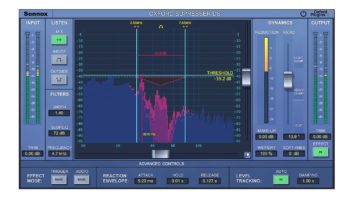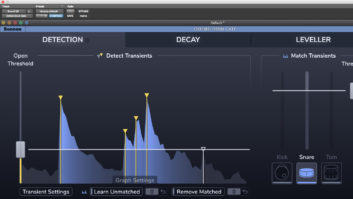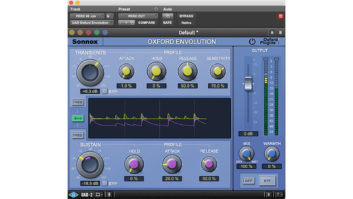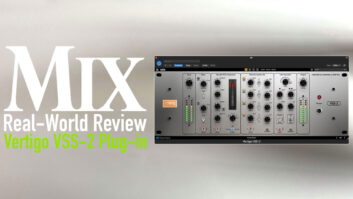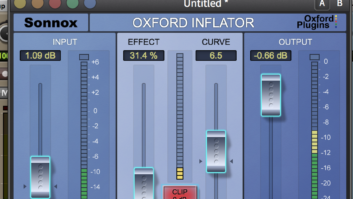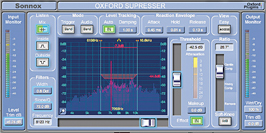
Oxford SuprEsser ships in three kernel sizes: Standard, High-Resolution and Low-Latency
Sonnox is an independent company that was formerly affiliated with Sony UK and known as Sony Oxford Plugins. However, team members have largely stayed the same, and they continue to expand the company’s popular Oxford line of plug-ins. The company’s first new entry, Oxford SuprEsser, uses the same attractive, highly intuitive GUI design from the Oxford plug-ins. Both a highly-featured de-esser and sophisticated dynamic EQ, this plug-in operates over the entire audio spectrum, making it useful on both vocal and instrument tracks — including bass, percussion and drums — as well as on program material during mastering.
Easy or Advanced Operation
When I launched the Pro Tools RTAS version in Easy edit view mode, I was provided with only basic filter and dynamics controls, plus a large FFT (Fast Fourier Transform) window to help identify the frequencies in need of treatment and set the threshold. There’s a range of controls for setting the compression threshold, center frequency and left/right boundaries of the bandpass and band-reject filter pair. A vertical red “FFT peak line” is always present, holding for your attention the “important frequency” in the band window, which has the peak energy. An attenuation meter with peak-hold indicates the maximum amount of reduction occurring over the past couple seconds, and a dynamics In button allows for glitch-free comparisons, with (and without) the gain-reduction effect. Three listen modes let you hear the Mix, the output of the bandpass filter (Inside), or the output of the band-reject filter (Outside), while a Wet/Dry balance can blend part of the uncompressed signal with a highly compressed version for added punch.
Pressing the More button in the Dynamics section opens up an advanced view. This offers all the basic components described above, but adds deeper control over dynamics — such as Attack, Hold and Release of the reaction envelope, and compression Ratio/Soft-Knee — plus the ability to reconfigure the signal flow through the filters.
Say It — Don’t Spray It
The Oxford SuprEsser ships with a few dozen presets, categorized from utility use and various instrument treatments to effects. I particularly enjoyed the more esoteric presets, such as Outside Ducks Inside and Sub Bass Make-Up, which inspired me to dig into the advanced edit view and use SuprEsser in very creative ways.
As a de-esser, the plug-in performed very well on sibilants and fricatives in all voice tracks. On spoken-word/narratives, I had natural-sounding de-essing results straight from Easy mode, using a fairly wide band with only moderate compression. Whenever the voice talent leaned too close to the mic, a pass with the filter band tightly focused on the low end and removed plosives and thuds without affecting neighboring frequencies. To try out the Whistle Control preset, I had to cook up my own gap-tooth track, but the 0.2-octave filter band did the trick while minimizing the need for an Advil, without affecting the clarity, presence or carving a tell-tale notch of traditional EQ.
On tricky vocals — especially edgy female pop/rock where sibilance can result from “stylistic flair” — I found that setting a narrow detection band and fine-tuning the threshold and ratio controls would magically separate the two characteristics, ensuring that you won’t end up with an overly de-essed or lisp-like vocal with all the high frequencies missing. And with default Auto-Level Tracking switched on, the detection peak accurately chased the anomalies through every emotive shift in pitch and projection of the vocal. Reduction was exceptionally smooth and uniform. Because it’s a relative measure, tracking will apply more attenuation in the verses but not over-de-ess in louder sections, such as the chorus. There’s even a 24dB “working range” that’s smartly implemented within the tracking algorithm to prevent excessive gain reduction following periods of staccato speech or silence. With tracking switched off, you return to fixed-threshold compression.
There are some fantastic presets for De-Twanging acoustic guitar; DeRasping saxophone and removing harshness of trumpet; taking the nasal quality out of a cello using a notch in the 2 to 4.5kHz region; and reducing key-tapping and embouchure blow on wind instruments — all of which worked extremely well. The magic appears to be in the well-defined crossover filters and their variable slopes, yielding excellent and very natural-sounding separation of Inside from Outside.
Decisions, Decisions
Following years of market drought, we’re seeing a flood of quality de-esser releases in 2008. With the release of Empirical Labs’ new 500 Series-compatible DerrEssing Limiter hardware module, the Eiosis E2Deesser, McDSP’s DE-555 and Steven Massey’s De:Esser, there are ample choices when it comes to taming sibilance. These solutions, however, tend to fall on either the quick-set or high-tweak side of the fence.
I like the Sonnox approach, which provides the simple two-step “cutoff and attenuate” setup process of a conventional de-esser, but with all the creative benefits of a frequency-splitting dynamic EQ with reaction envelope. However, the SuprEsser’s structure doesn’t allow for any post-detection filtering or parametric EQ (for independently contouring the inside and outside parts) in the way that the Eiosis E2Deesser does, for example.
Oxford SuprEsser uses floating point processing, which makes it incompatible with the TDM platform. It also uses convolution, requiring an “Impulse Response Kernel” to model the response of the Oxford desk filters. The math behind this process draws heavily on CPU resources and the size of this kernel (measured in samples) determines both the plug-in’s delay and the accuracy of the modeling, especially when dealing with lower frequencies. To address these issues, the Oxford SuprEsser ships in three kernel sizes: Standard, High-Resolution and Low-Latency.
Depending on your audio buffer size, the delays can be exorbitant: In a 96kHz session using a 256 audio buffer size on the high-res version, Pro Tools HD reported a track delay of 12,200 samples, which went beyond its ability to compensate automatically. As far as live use goes, even the low-latency model yielded a delay in the region of 660 samples at 44.1 kHz and 256 audio buffer size, which proved impractical for tracking or monitoring signals directly from the mic. This is a shame, because Oxford SuprEsser delivers a host of fantastic sounding tools in a simple package that would be just as desirable to have at a venue as on record. All that said, this is an affordable, strong and highly specialized production tool with a scalable GUI that is a winner.
Jason Scott Alexander is a producer/mixer/remixer in Ottawa, Canada.

